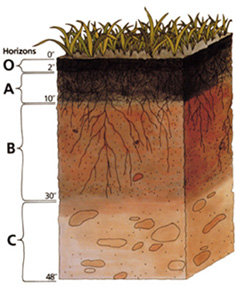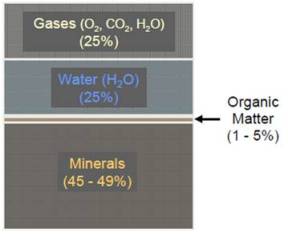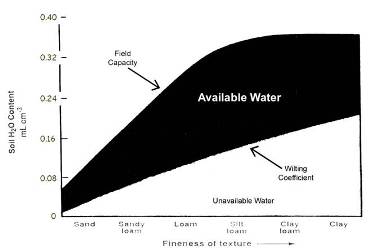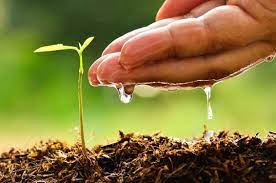Courtesy : climate-woodlands.extension.org
Soil and water
Soil water availability is the capacity of a soil to hold water that is available for plant use. A soil is simply a porous medium consisting of minerals, organic matter, water, and gases. The traditional definition of soil is: Soil is a dynamic natural body having properties derived from the combined effects of climate and biotic activities, as modified by topography, acting on parent materials over time.
Figure 1. Diagram of a typical soil profile.


The capacity of a soil to hold water is largely dependent on soil texture. Soil comes in a variety of textures but results from two principal mineral types. Primary minerals, such as those found in sand and silt, are those soil materials that are similar to the parent material from which they formed. They are often round or irregular in shape. Secondary minerals, on the other hand, result from the weathering of the primary minerals, leading to the formation of platelike particles called clay. Clays have a large surface area, which is important for soil chemistry and water holding capacity. The texture of a soil is based on the percentage of sand, silt, and clay found in that soil. The identification of sand, silt, and clay are made based on size. The following is used in the United States:
Sand 0.02 – 2.00 mm in diameter
Silt 0.002 – 0.02 mm in diameter
Clay < 0.002 mm in diameter

Figure 2. The USDA Soil Texture Triangle.
The texture of a soil can be determined from its sand, silt,
and clay content using a textural triangle. The triangle on
the right (Figure 2) is the one created by the U.S. Department of Agriculture’s Natural Resources Conservation Service and is primarily used in the United States. There are various textural
triangles used throughout the world but most are
similar. Percent clay in this triangle is read on the lefthand side of the triangle, the percent silt is read on the righthand side of the triangle, and the percent sand is on the bottom of the triangle. For example, if a soil contains 20% clay, 40% sand, and 40% silt (total = 100%), then it is a loam.

Figure 3. A plant’s available water holding capacity for soils with different textures.
The texture of a soil is important for soil water availability because it controls not only how well a soil can hold water but also how well water is absorbed into the soil. Any water that infiltrates into a soil does so primarily through large pores in the soil called “macropores” that are created by plant roots, microorganisms, and physical processes such as freezing and thawing and drying and wetting. These processes help form conglomerations of soil particles called “aggregates” that are held together in part by organic molecules that originated from plants, animals, and microorganisms. Aggregates help form soil structure – which in turn helps maintain macropores and good infiltration capacity. Good soil structure also improves soil aeration for both roots and microbes.
Once water has entered the soil it is held through capillary action by the small interparticle spaces called “micropores.” This is very similar to a paper towel absorbing spilled water. The coarser the texture, the fewer small spaces exist and the less water the soil can hold. An example might be water running through a jar of marbles, without being held. Alternatively, a very fine sponge will hold water until all the micropores are filled, at which point excess water runs through. For a soil, this point is called the “water holding capacity” or “field capacity.” Soils with different textures and levels of aggregation have very different water holding capacities as shown in Figure 3. For trees to absorb water from a soil, it must be held at an energy level that trees can use. Sand, which is fairly coarse with limited micropores, has a very poor water holding capacity versus clay that is a matrix of very fine pores. Although clay can hold the most water of all soil textures, the very fine micropores hold water so tightly that plants have great difficulty extracting all of it. The point where water is held microscopically with too much energy for a plant to extract is called the “wilting coefficient,” and in general, water in such a state of energy is not available for most plants to extract. Thus, loams and silt loams are considered some of the most productive soil textures because they hold large quantities of water that is available for plants to use.




